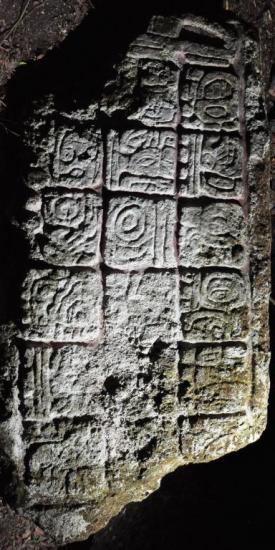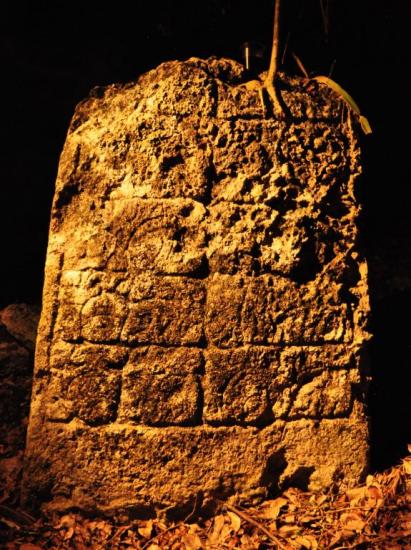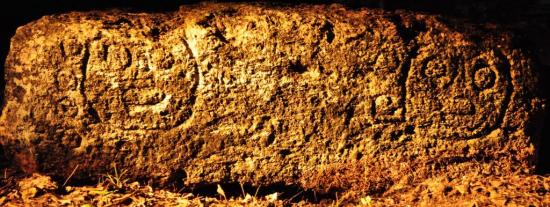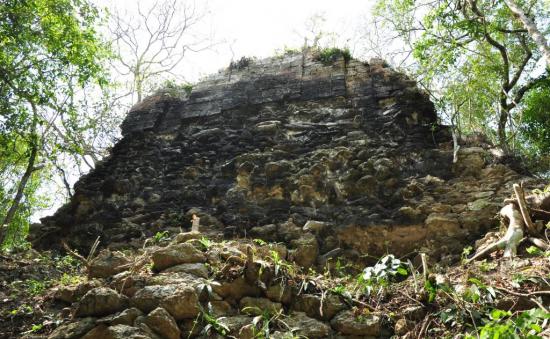PART.2
Also found at Lagunita were 10 stelae and three altars, some of them with well-preserved reliefs, including hieroglyphic inscriptions.

Lagunita, Stela 2, front
“The date on Stela 2 corresponds to A.D. 711, suggesting that Lagunita flourished contemporarily with the nearby Chactún, where we also found monuments with dates falling in the eighth century,” says project epigrapher Octavio Esparza. “To judge by both architectural volumes and monuments with inscriptions, Lagunita must have been the seat of a relatively powerful polity, though the nature of its relationship with the larger Chactún, lying some 10 km to the north, remains unclear.” The importance of Lagunita is further attested by the great density of residential mounds, terraces,albarradas (low dry walls) and other settlement remains in the surrounding area.

Lagunita, Stela 4, upper fragment, left side

Lagunita, Altar 1, west face with glyphs 4 Ajaw and 2 Ajaw
Similarly imposing is the site of Tamchén, located about 6 km northeast of Lagunita: there are several plazas surrounded by voluminous buildings, including a pyramid temple with a rather well preserved sanctuary on top and a stela and an altar at its base, as well as an acropolis supporting a courtyard with three temples on its sides. While Tamchén seems to have been largely contemporaneous with Lagunita, both the triadic compound and surface ceramics indicate its settlement history goes back to the Late Preclassic (c. 300 B.C. – A.D. 250).

Tamchén, Structure 1, north side
Just like Chactún, Lagunita and Tamchén have a number of aspects that make them very promising for future research. The zoomorphic façade at Lagunita does not come as a surprise, considering that Becán, the largest site in the Río Bec zone, is only 15 km away. What has not been expected, however, is the presence of so many pyramid temples and monuments with inscriptions, which are rare in the Río Bec región. Both Tamchén and Lagunita appear to have been largely abandoned around A.D. 1000, sharing the fate of other lowland Maya polities, but a few stelae were modified some time after they had been originally erected, and Postclassic offerings were found at others. These facts obviously reflect continuities and ruptures in cultural traditions, but their significance for understanding political geography and history of the region is yet to be explained.
Particularly interesting are various elements that have not been known elsewhere in the Maya area. Two altars of Lagunita have a curious nail-head shape. The third one is rectangular and has a series of Ajaw glyphs on its sides, with coefficients evidently referring to successive k’atun (20-year period) endings; such records are common in codices, but not on stone monuments. Whereas hieroglyphic texts normally appear in an even number of columns, the inscription on Stela 2 of Lagunita has three, and the Long Count date is incomplete. At Tamchén, dozens of chultuns are scattered in two plazas; some are partially collapsed or filled-in with material accumulating through centuries, but others are even nowadays 10 or more meters deep. Whereas chultuns are common at Maya sites, their depths and high concentration within the civic and ceremonial center of the ancient settlement represent a peculiarity of Tamchén. Only future research in the extensive archaeologically unsurveyed region to the north may reveal whether such characteristics, which at the moment appear to be rather unique, were in fact common in a wider area.
Representing a follow-up of the project of Archaeological Reconnaissance in Southeastern Campeche, Mexico, directed by Ivan Šprajc since 1996, the 2014 field season was approved and supported by the National Institute of Anthropology and History (INAH), Mexico. Lead funding was provided by Ken and Julie Jones from their KJJ Charitable Foundation (USA); additional financial support was granted by private companies Villas (Austria), Hotel Río Bec Dreams (Mexico) and Ars longa and Adria Kombi (Slovenia), as well as by Martin Hobel and Aleš Obreza.
In June 2014, the southern part of the Calakmul Biosphere Reserve, where most of the currently known archaeological sites were discovered in field surveys headed by Šprajc in recent years, was inscribed in the UNESCO World Heritage list as a mixed natural and cultural property.